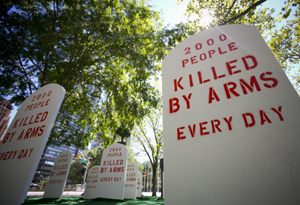EDITORIAL
The Arms Trade Treaty, a new instrument for arms control

For the second time, this e-review will focus on the Arms Trade Treaty (ATT), adopted by the United Nations in April 2013. This is an indication of how important the ATT may be. Its importance is, above all, symbolic. However, it may also serve to regulate the behaviour of states and — indirectly — private actors, depending on the actual results once the treaty enters into force. We wished to look at the different, sometimes conflicting, reactions it has provoked among activists, experts and academics, as well as among states and businesses. These reactions range from complete satisfaction to total and instant pessimism, as well as a whole range of intermediate opinions. The truth is that the ATT has generated expectations and controversy from the beginning, from the long and complicated period of gestation of the UN mandate for the negotiations, through to the negotiations themselves on the basis of the mandate finally adopted, with the disappointment of July 2012.
The articles collected here reveal some of these nuances of opinions and expectations. I will therefore limit myself to making a few brief comments on the start of the ratification process for the ATT. I will do so on the basis of one key idea: we are talking about a new instrument of arms control, not an instrument for disarmament, and that implies more limited objectives from the outset. However, some instruments of arms control have in the past produced excellent results. Everything depends, apart from what is laid down in the treaty, on how this is implemented and, above all, how it is interpreted, according to a principle often invoked when discussing international law: anything which is not explicitly forbidden is permitted.
Firstly, we must always bear in mind that arms control instruments are intentionally pragmatic: they seek to reduce the likelihood of war, its scope and the violence which may be used in war. In other words, arms control has one or several of the functions in the following list: 1) to freeze, limit, reduce or eliminate categories or designs of certain weapons; 2) to avoid certain military activities; 3) to regulate the deployment of armed forces; 4) to prohibit transfers of certain important military items; 5) to restrict or prohibit the use of certain weapons; and 6) to create trust through measures of openness and transparency. In this case, the ATT focuses on the fourth function, no more and no less. In short, the ATT will not, under any circumstances, be an instrument for ending the arms trade; it was created with the aim of regulating certain transfers in some specific situations.
Secondly, an empirical, scientific approach obliges us to be aware that currently we only have opinions and conjectures: positions that will have to be proven or refuted by the facts. At the moment, it is not possible to present rational arguments which demonstrate that the ATT will be a success or a failure. Everything will depend on its implementation and, therefore, on the capacity to exercise pressure for as restrictive a regulation as possible. We have to be rigorous with our analysis… but when the time comes: when there are results.
Thirdly, the process of ratification until the coming into force of the treaty is of crucial importance. We must recall that, besides the votes against, there were a significant number of abstentions, above all for the reasons formally given (in the case of the countries of the so called "Bolivarian" alliance) and, very importantly, because at least three of the abstentions came from countries which are very important in the arms trade. If the US does not ratify the ATT, or takes a long time to do so, the balance of power in their parliaments means that many arms exporting countries could remain outside the treaty. There is thus a lot of work to be done.
And fourthly, over the two or three years that may pass until the treaty comes into force (ninety days after having reached fifty ratifications) a lot of pedagogy and other work has to be done: preparing simple, clear and neutral instruments for the application of the treaty; teaching states to evaluate the causes for prohibitions and restrictions; establishing standards and accepted criteria. We can not know right now whether the glass is half full or half empty, but we do know that the final result depends on what all of us do from here on.